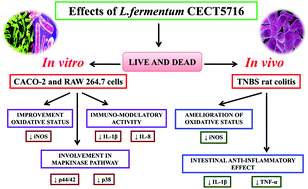The viability of Lactobacillus fermentum CECT5716 is not essential to exert intestinal anti-inflammatory properties
Abstract
Probiotics have been used as alternative therapies in intestinal inflammatory disorders. Many studies have shown that different bacterial probiotic strains possess immuno-modulatory and anti-inflammatory properties. However, there is an increasing interest in the use of non-viable bacteria to reduce the risk of microbial translocation and infection. The aim of this study was to evaluate whether the viability of L. fermentum CECT5716 is essential to exert its intestinal anti-inflammatory effect. We compared the preventative effects of viable and non-viable probiotic in the TNBS model of rat colitis. In vitro studies were also performed in Caco-2 and RAW 264.7 cells to evaluate the probiotic effects on IL-8, IL-1β and nitrite production, and p44/42 and p38 MAP kinase protein expressions. In vitro results revealed a decrease in the stimulated production of pro-inflammatory mediators regardless of the viability of the probiotic. Likewise, both forms of the probiotic administered to colitic rats produced a significant reduction of IL-1β and TNF-α levels and colonic iNOS expression. In conclusion, both live and dead L. fermentum CECT5716 have been demonstrated to attenuate the inflammatory process and diminish the production of some of the inflammatory mediators. In fact, the viability of this probiotic did not affect its immuno-modulatory and anti-inflammatory properties.


 Please wait while we load your content...
Please wait while we load your content...